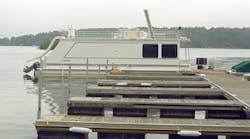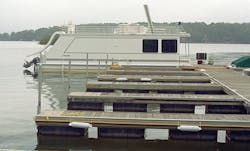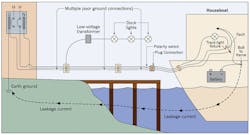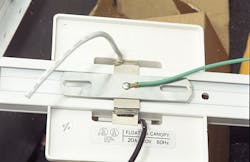Soon after a young family purchased a vacation condominium on a local lake, they were anxious to entertain guests. One summer weekend, they invited another couple and their daughters to visit: Tim and his wife Liz, their older daughter Jenny (age 9), and younger daughter Laura (age 2). Toward the end of an eventful day at the lake, both families decided to take a walk along the docks down by the marina, which housed several boat slips.
Although the condo owners (Joe, Cindy, and infant son) did not own a boat, they were in the market for one. As they walked along, examining the different models, a large houseboat at the end of the dock immediately attracted their attention (Photo 1). They walked over and started chatting with the boat owner, Dave, and his girlfriend, Kim. While taking a tour of the cabin, Kim asked Jenny if she would be interested in going down the waterslide at the back of the houseboat. Like most girls her age, Jenny jumped at the chance to try out the slide. Unfortunately, the events that transpired would quickly turn a seemingly harmless bit of water fun into pure tragedy.
The accident
Dave turned on the water pump, and with the owners' approval, Jenny climbed up to the roof and slid down the slide. She quickly popped up from the water approximately 10 feet away and grabbed onto a life preserver Dave threw toward her. Holding it to her chest, she began paddling to the rear of the boat. As she got closer to the ladder, however, she began to feel numbness and tingling in her legs. When she was within 4 or 5 feet, she could no longer feel the lower half of her body at all. She screamed out in pain that something was stinging her. Thinking it might be a snake, Joe immediately jumped into the water to help, pushing Jenny toward the rear of the boat.
At the same time, Tim, the girl's father, grabbed onto a metal railing and leaned out over the water to grab Jenny. As he was leaning forward, he slipped into the water but still kept hold of the railing. Quickly, he felt his body painfully tighten and found that he could not release his hands. He was left hanging to the side of the boat in obvious pain. Although Cindy and Liz pleaded with him to let go, Tim told them in slow, contorted speech that he simply could not. Realizing that it might be an electrical problem, Dave ran to the front of the boat and unplugged it from shore power. This immediately allowed Tim to free his grip, and the others helped him back onto the rear deck. Soon thereafter, Jenny also was able to make it to the rear ladder and climb out of the water.
As the chaos subsided, the group's attention soon turned back to Joe, who was nowhere to be found. Dave and another bystander dove into the water and found Joe near the bottom of the lake. They pulled him onto the rear deck and began to perform CPR while another bystander called 911. Unfortunately, Joe never regained full consciousness, and he later died at the hospital. An autopsy concluded that Joe had been electrocuted. In addition, the shock Tim received left him with lasting injuries. Fortunately, Jenny did not suffer any long-term harm.
Investigation and analysis
Based on the circumstances surrounding the accident, the sheriff's department hired a local electrician to assist in the investigation. He initially tested for voltage between the metal dock and the water. Finding none, he plugged the houseboat into shore power and measured the voltage between the water and various locations on the boat. The results were as follows:
- Portside stern (location of the ladder): 100.6VAC
- Starboard stern: 96.7VAC
- Starboard bow cleat: 112.3VAC
After unplugging the boat from shore power, no voltage potential was found at any of these points. Finally, the electrician performed a continuity test on the hot leg of the 120V shore power. A direct short was found between the hot leg and the hull of the boat. These initial tests showed that the water surrounding the boat was effectively energized to line voltage whenever the boat was plugged into shore power.
Anderson Engineering was hired on behalf of the plaintiff (victim's family) to investigate the accident and determine the particular failure mode that led to the accident. During our preliminary examination, we tracked the shore power connection, finding that 120VAC power originated from a metered disconnect located on the exterior wall of a nearby condo. Underground conductors traveled to a receptacle mounted on shore near the dock. A low-voltage lighting transformer powering several dock lights was plugged into the receptacle.
The circuit traveled onto the dock and powered a second duplex receptacle. The run continued on to a 30A female plug-in cord receptacle. A final extension cable traveled from there to a male receptacle on the side of the boat. Closer inspection of the extension cable revealed that the hot and neutral were reversed in the cable-to-cable connection.
Further examination of the houseboat's electrical system and components exposed a faulty interior track lighting fixture. As shown in Photo 2, the neutral fixture wire was damaged as it passed out of the covered wiring compartment. Unless the fixture wires were correctly routed during the manufacturing process, the edges of the grounded mounting plate would cut into the conductor insulation when the wiring compartment cover was installed. In this case, the neutral was effectively connected to electrical ground.
The damaged “neutral,” in combination with the reversed polarity, created a dangerous situation. Under normal circumstances on a land-based electrical system, the fault current would have traveled to earth ground. Then, depending on several factors, including the circuit load, the location of the ground fault, and the condition of the ground connection, the rise in current would most likely have tripped the overcurrent protection. However, this did not occur, due to the peculiarities of marine power systems and their interconnection with land-based systems.
Rules and regulations
Rules regarding marina electrical systems are laid out in NFPA 70, (National Electrical Code) Article 555: Marinas and Boatyards. The Article bases all shore wiring systems against the electrical datum plane. In general, the datum plane is a horizontal plane below which no electrical services, outlets, or connections are allowed. The Article further specifies rules regarding connections to boat AC power systems. The shore power system at the condo complex in question violated several provisions of the 2008 NEC, including:
- The final cord-to-cord connection mentioned earlier was not at least 12 inches above the deck of the floating pier, which was a violation of 555.9 and 555.19.
- The final receptacle was not housed in a listed marine power outlet and was not protected from the weather [555.19(A)(1)].
- The shore power disconnecting means was at the circuit breaker panel on shore, and not within 30 inches of the boat receptacle, as specified in 555.17(B)
- Wiring above the deck was not protected by rigid or nonmetallic conduit, as required by 555.13(B)(5).
- The cable connection to the boat was routed through a rough hole cut in the side of the metal dock frame, violating several Code sections relating to workmanship and protection of conductors (110.8, 110.12, 110.27, etc.).
NFPA 303: Fire Protection Standard for Marinas and Boatyards covers the design and construction of marinas and boatyards with respect to fire and life safety. NFPA 303 also contains a less well-known section on electrical equipment that complements the NEC. While much of NFPA 303 Chapter 5 restates or references the NEC, it also specifies additional warnings and safety measures, as well as presenting specific receptacle configurations approved for shore power connections.
In particular, NFPA 303 requires that insulation integrity of the electrical system shall be tested upon completion of the installation (5.18.10). All receptacles must be tested for ground integrity and polarity prior to use (5.18.2). Finally, 5.20 provides criteria for regular inspections (at least annually) of the entire shore power system for damage, improper additions, ground integrity and polarity, and several other safety hazards.
While the NEC and NFPA 303 cover shore-based electrical systems, they do not cover the internal electrical system of a boat itself. Safety standards for boat wiring are laid out in ABYC E-11, a publication produced by the American Boat and Yacht Council. Although that standard is beyond the scope of this article, one section plays a major role in cases of this type — the requirement that the boat's internal AC system ground be bonded to the DC ground. Normally, the DC ground/neutral is simply a connection from the negative battery terminal to the boat's hull.
When the boat is connected to shore power, the boat's AC system is bonded through the grounding conductor back to a grounding electrode on shore. As long as the shore-to-boat grounding connection is solid, any ground-fault current will travel back to shore and trip the circuit's overcurrent protection. However, if the shore-to-boat grounding connection is severed, or even slightly weakened, fault current will travel through a parallel path created by the bonded AC/DC ground connection on the boat. As the AC/DC ground is basically a direct connection to the hull, fault current will energize the boat hull. Stray current then travels through the water in an attempt to reach shore, and the shore power grounding electrode.
In many cases, this parallel path is weak, as the voltage decreases with distance away from the hull. The current most likely will not be sufficient to trip the shore overcurrent protection, and the fault will continue indefinitely. That is why a strong, continuous grounding path back to shore is imperative.
Lessons learned
With this in mind, it may surprise you that ground-fault protection is not required for shore power circuits. It is only required for 15A and 20A circuits in marinas and boatyards that are not used for shore power. The reason for this is also beyond the scope of this article. However, it relates to the problem of nuisance tripping, because there often may be a small amount of current traveling through the parallel grounding path. Keep in mind that this does not prevent the use of GFCI protection on these circuits; it is just not required.
Severing the bond between the AC and DC systems on the boat would be another way to stop this problem, but the bond is there for good reason. For one, if there is an AC ground fault on the boat, and the shore ground connection is poor, it creates a shock hazard for those in the boat if they make contact between an energized AC source and the grounded boat hull. Secondly, a fault connection could create enough heat to ignite a fire before the overcurrent protection could trip.
Back to our case, the reversed polarity of the shore power system, and the faulty light fixture resulted in a direct connection to ground. The poor condition and distance of the shore power grounding conductor made for a weak grounding path, and a parallel path formed through the water surrounding the houseboat. The voltage decreased as the distance away from the boat increased, so the current could not break the skin until Jenny was closer to the boat. Once she was within sufficient distance, the fault current, although small, was enough to paralyze the lower half of her body.
When Joe jumped in to save her, he was also shocked. Most likely, he was paralyzed by the fault current, causing him to sink below the surface — where he eventually drowned. Therefore, his death could be termed what is known in the industry as “electric shock drowning,” rather than an electrocution. Tim also suffered a paralyzing shock, but in a surprising twist he was actually saved because the current was high enough to hold his grip on the boat and prevent him from sinking.
Notwithstanding the defective light fixture and reverse polarity condition, if all the provisions of the NEC, NFPA 303, and ABYC standards were followed, the tragic death of a young father may have been prevented. A strong shore power ground path, proper and regular inspections of the marina electrical system, and GFCI protection could have prevented fault current from energizing the water. Modern boats may also be equipped with isolation transformers to isolate the shore AC from the boat's internal AC system. Furthermore, electronic devices are also available that can check for low levels of ground-fault current and alert management of the danger.
Based on the facts of this case, a lawsuit was filed against the several defendants, including the houseboat owner, the marina/condo management company, light fixture manufacturer, and houseboat manufacturer. An undisclosed settlement was reached between all parties prior to trial.
Paris is a forensic electrical engineer with Anderson Engineering, New Prague, Minn. He can be reached at [email protected].
SIDEBAR: Water and Electricity Don't Mix
As always, there is more to this saying than meets the eye. Pure H2O is actually a poor conductor of electricity. Water becomes a better conductor as the amount of minerals and impurities increases. For instance, the conductivity of seawater is much better than normal lake water. Again, this plays a significant role in the cause of marine shocks and electrocutions.
When a ground fault situation occurs in the ocean, the conductivity of seawater is much higher than the conductivity of the human body, so the fault current would travel through the seawater and not through the relatively high-resistance path of the body. The situation in lake water is reversed. The salinity of the human body makes it a better conductor than the surrounding lake water, and much of the fault current is shunted through the body.
SIDEBAR: When Electricity and Water Must Mix
A bright sunny day, a clear cool lake, and a large well-equipped boat — combine them together and it sounds like a recipe for fun, right? From the smallest outboards to the largest cabin cruisers, today's boats are more powerful, efficient, and technologically advanced than ever. Larger vessels are often more like second homes, with kitchens, living areas, and bedrooms containing every modern convenience.
Many larger recreational boats have several 12VDC or 24VDC circuits powered by batteries or alternators. These circuits are typically used to power lights, radios, depth-finders and other DC-powered devices. Larger appliances, such as refrigerators and air conditioners, can also be found in DC-powered versions.
Larger cabin cruisers or houseboats may contain many items that operate on AC power, as these devices are typically more readily available and more powerful than their DC-powered counterparts. If necessary, power inverters or generators can then be used to power these 120/240VAC devices. Stable power is typically provided by a connection to AC shore power while the vessel is in port. A shore-power electrical connection is definitely convenient for the operator, but that convenience is coupled with unique hazards not found on purely land-based electrical systems.






